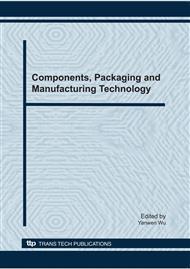[1]
Qi Mei, Wang Yan. A Case Study of Zhangqiu City: Assessment of Comprehensive Benefit of Land Consolidation. Resources & Industries (2008), pp.62-66 (in Chinese).
Google Scholar
[2]
Zhou Fei, Chen Shiyin, Zhong Laiyuan, Wu Mingfa. Evaluation on Comprehensive Benefit of Land Consolidation in Yuan District Liuan city, Anhui province. Guangdong Agricultural Sciences (2008), pp.107-109 (in Chinese).
Google Scholar
[3]
Fan Jinmei. The Study of Profit Evaluation of Land Consolidation. China Land. (2003), pp.14-15 (in Chinese).
Google Scholar
[4]
Li Yongchuan. A Case Study of Beijing: Profit Evaluation Index System of Land Consolidation. Resources & Industries. (2008), pp.70-73 (in Chinese).
Google Scholar
[5]
Huang Zhonghua, Wang Zhanqi, Gong Jian. A Preliminary Research into Potential Evaluation of Farmland Rearrangement by Multi-factor Assessment—With Baokang County, Hubei Province as an Example. Management Geological Science and Technology. (2004).
Google Scholar
[6]
Guan Tao, Shen Yongyang, Yu Wanjun,Zong Xiaojie,Li Xuemin. National economy evaluation method of land consolidation project. Transactions of the Chinese Society of Agricultural Engineering. (2005), pp.146-149 (in Chinese).
Google Scholar
[7]
Wu Huaijing, Yang Shan. The Indicator System for Land Arrangement Assessment Based on the Sustainable Development. Geography and Geo-Information Science. (2004), pp.61-64 (in Chinese).
Google Scholar
[8]
Qin Shiya, Yin Huibin. Studies on the Evaluation of Integrated Benefit of Land Arrangements Based on AHP. Journal of Hebei Agricultural Sciences. (2007), pp.93-96 (in Chinese).
Google Scholar
[9]
Li Yan, Zhao Gengxing, Wang Ailing, Zhang Ren. Evaluation index system for land consolidation benefit and its application. Transactions of the Chinese Society of Agricultural Engineering. (2006), pp.98-101 (in Chinese).
Google Scholar
[10]
Zhao Xin. Status Quo and Applying on Agriculture Climate Resources in Drought Region of West of China. Science and Technology of Qinghai Agriculture and Forestry. (2006), pp.51-53 (in Chinese).
Google Scholar
[11]
Guo Xiaoming, Du Wei, Xu Wei, Huan Shanming. Analysis of Land System Innovation Under the Construction of Ecological Rehabilitation in Arid River Valley in Western Regions. Theory and Reform. (2004), pp.148-150 (in Chinese).
Google Scholar
[12]
Satty T.L. Decision Making with Dependence and Feedback. RWS Publication, Pittsburgh, PA, pp.84-136(2001).
Google Scholar
[13]
Tang Xiaoli, Feng Junwen. ANP principle and Prospect of Using. Statistics and Decision. (2006), pp.138-140 (in Chinese).
Google Scholar
[14]
QianZheng. The Model of Logistics Network Performance Evaluation Based on ANP. China Collective Economy. (2008), pp.37-38(in Chinese).
Google Scholar
[15]
Liu Rui, YU Jianxing, Sun Hongcai, TianPing. Introduction to the ANP Super Decisions Software and Its Application. Systems Engineering-theory & Practice. (2003), pp.141-143 (in Chinese).
Google Scholar
[16]
Zhang Min. Sustainable study of Land Consolidation Project—With Hong An County, Hubei Province as an Example. Journal of Xianning College. (2007), pp.100-103(in Chinese).
Google Scholar


